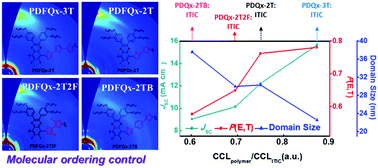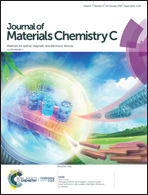Influence of backbone modification of difluoroquinoxaline-based copolymers on the interchain packing, blend morphology and photovoltaic properties of nonfullerene organic solar cells†
Abstract
In order to understand the influence of molecular ordering and orientation on the performance of nonfullerene (NF) solar cells, we synthesized a series of difluoroquinoxaline-based alternating copolymers: starting from poly(2,2′-bithiophene-alt-(2,3-bis(3,4-bis(octyloxy)phenyl)-6,7-difluoroquinoxaline)) (PDFQx-2T), we modified the polymeric backbone by incorporating fluorine atoms (PDFQx-2T2F) or thiophene (PDFQx-3T) or a benzene ring (PDFQx-2TB) in the bithiophene comonomeric unit. The structure modification significantly affected the photovoltaic performance with power conversion efficiencies (PCEs) of 3.95% for PDFQx-2TB:ITIC, 4.82% for PDFQx-2T:ITIC, 4.93% for PDFQx-2T2F:ITIC and 8.13% for PDFQx-3T:ITIC. The dramatic increase in the PCE of PDFQx-3T:ITIC was attributed to improvements in the short-circuit current density (JSC) and fill factor (FF). From the resonant soft X-ray scattering and grazing incidence X-ray scattering measurements, the PDFQx-3T polymers had well-developed, face-on oriented crystallites, allowing the formation of face-to-face alignment with the face-on ordered ITIC molecules at the interfaces. Also, the PDFQx-3T:ITIC blend films exhibited well intermixed blend morphology with smaller domain spacings. These combined features contributed to efficient charge generation with the highest exciton dissociation probability among the four different polymer:ITIC systems. In addition, dominant face-on orientation of both PDFQx-3T polymers and ITIC acceptors with a balanced crystalline coherence length ratio (CCLpolymer/CCLITIC) (0.87, based on the out-of-plane (010) diffraction peaks of PDFQx polymers and ITIC acceptors) led to a more balanced charge mobility than other blends, explaining the highest JSC and FF in the PDFQx-3T:ITIC NF devices.



 Please wait while we load your content...
Please wait while we load your content...